Introduction
The second decade of the 21st century has faced challenges that, it was thought, were losing momentum in the process of continuous change throughout time. The religious extremists that destroyed world heritage historical and cultural monuments, as well as the economic Neo-Protectionism are two scenarios that have acquired new relevance in the international scene.
In this context, the multidisciplinary research enriches the understanding of the relation between actors of diverse areas of knowledge that are, apparently, unrelated, as it is the case of economic science and culture. Nevertheless, in an international level, there is research that shows the articulation existing between economy and cultural affairs, although in Mexico these studies are scarce, despite the fact that Cultural Economics involves a significant number of research pathways.
In recent years, the Instituto Nacional de Estadística y Geografía, INEGI (National Institute of Statistics and Geography) through the Sistema de Cuentas Nacionales de México (National Accounts Systems in Mexico), has published a compendium of documents related to topics or economic indicators of culture. Among them, it is important to mention the Metodología de la Cuenta Satélite de la Cultura de México (INEGI, 2013), Cuenta Satélite de la Cultura de México 2008-2011, (INEGI, 2014), Cuenta Satélite de la Cultura de México 2013 (INEGI, 2015), and Cuenta Satélite de la Cultura de México (INEGI, 2016). Based on said documents, it is possible to emphasize the inclusion of the cultural activity of the country in the National Accounts, and its participation in the national Gross Domestic Product (GDP) that, for the period from 2007 to 2015, has represented about 2.7%.
Nevertheless, there is not much research that allows obtaining a broad understanding of the cultural economics of this country. We can only quote the study by Piedras (2004, 2006), and Becerril, Munguía, and Canales (2017). Piedras, in his 2004 document, analyzes the worth of culture in Mexico focusing on the industries protected by copyright. In 2006, the macroeconomic numbers of the contributions from the cultural sector to GDP were checked and compared to the results from other countries to place Mexico in an international context. As for Becerril et al. (2017), they analyze the efficiency of the cultural goods and services in Mexico. However, when we want to learn more about the effect that the usage of factors has had on production and technical efficiency of Culture in Mexico, there is no research on these topics. As a result, it is identified an analytical gap, and, consequently, this document intends to contribute to the better understanding of it.
The objective of this research is to obtain the technical efficiency of the cultural goods and services in Mexico, as well as the activities that integrate them. To achieve said purpose, in section two, the theoretical framework that serves as the basis for this research is presented. In section three, an assessment of the studies related to economy and culture is included to identify the lack of studies regarding the Mexican case. In section four, it is introduced the methodology to be used for empirical application, and in section five the obtained results are shown and analyzed. Finally, the main conclusions are reported.
Theoretical framework
A link that has been hardly studied in the economic science is the one existing between economy and culture. One of the first formal approaches to this problem can be found in Baumol and Bowen (1965), where an effort is made to articulate the performing arts with the economic analysis. The study by Baumol and Bowen has generated the will to strengthen the analysis of the relationship between these areas, as in the study by Blaug (1976) who gathered a compendium of readings related to this topic. Blaug (2001) wonders what the state of the art of cultural economics is. To this question, Becerril et al (2017) provide an answer for the Mexican case in relation to the efficiency of cultural goods and services.
Additionally, the will to contribute to the understanding of the relation between economy and culture motivates the analysis of the technical efficiency of the activities related to the cultural goods and services in Mexico. In order to do that, below it can be found a brief description of the theory underlying the production functions of the Stochastic Frontier, which allows delimiting methodologically the empirical obtaining of efficiency. Thus, in this section, it is made an approximation to the production technologies to delimit the central elements of the production functions of the Stochastic Frontier theoretically. This, in turn, provides the theoretical basis for the estimation of technical efficiency, which is the central element to learn more about the possibility to improve the usage of factors.
In order to delve more in-depth in the theoretical basis of the production functions in the context of economic science, Greene (1993) defines the production as a transformation process of a set of inputs, denominated
This isoquant is thus defined in the frontier of the set of inputs requirements. A more general definition is the efficient subset as shown below:
Moreover, Greene (1993) indicates that the distance function of Shephard (1953) is:
Naturally, if DI( y, x) ≥ 1 and the isoquant is the set of x, for which DI( y, x) = 1. Therefore the measure of technical efficiency oriented to the input of Debreu (1951)- Farrell (1957) is
Based on these definitions, it is followed that if TE ≤ 1 TE≤1 and if TE( y, x)= 1 /DI( y, x)the measure of Debreu-Farrell provides a starting point for the efficiency analysis. If it is defined in terms of production, it then refers to the technical efficiency.
Hence, if y≤f(x) defines the function of production with only one output, then, a measure of technical efficiency based on the Debreu-Farrell type of production is:
Which, for i enterprises, can be written as:
Where
The model of production will be generally linear and in logarithms of variables. Therefore the empirical counterpart will be
Where -ui ≥ 0 is a measure of technical inefficiency as
It is necessary to keep in mind that TEI = EXP(-ui)
This represents the fundamental theoretical framework for the econometric models of production that consider technical efficiency.
In the empirical applications, the referent alludes to Aigner, Lovell, Schmidt (1977), and Meeusen and Van Den Broeck (1977), who specify a function of Stochastic Frontier for a set of cross-sectional data. There they decompose the error component: one considers the random effects, and the other, considers the technical inefficiency. Thus, the proposed model has the following structure:
Where Y_i is the production or production logarithm of the i-th enterprise; xi is a (kx1) size vector of input quantities of the i-th enterprise; β is a vector of unknown parameters; and the Vi are random variables that are independent and identically distributed, i.i.d.,
For this study, it is used the methodology proposed by Battese and Coelli (1995) which uses a panel data structure.
Background
In Mexico, the analysis of culture and its relation to economy is relatively recent due to the lack of information regarding the economic activity of this sector; notwithstanding that, in the world, there is various analysis concerning particular topics of the cultural activity from the analytical perspective of the economic science. A study such as the one by Taalas (1997) analyzes a cost function for some theatres; the one by Herrero (2002) studies the cultural economics of Spain, and admits that in this country it is an emerging discipline. In the same year, Getzner (2002) through the analysis of time series analyzed the Australian Public Expenditure in Culture and if it is as essential as the expenses in Politics or the Government.
In 2003 Seaman (2003) did some research about an uncommon relationship: the articulation between Sports Economics and Artistic Research, arguing that the analysis of work in arts, in particular, could benefit itself from the Sports Research. In the area of technical efficiency, Basso and Funari (2004) analyze the usage of production factors using Data Envelopment Analysis applied to Italian Municipal Museums. Moreover, Throsby (2006) proposes a production function for the artistic production by building a model that specifies the amount of creative and commercial production, and the quality of creative production in relation to the contributions of working time and physical and human capital.
Towse (2008) proposes that the policy of copyright must be seen as part of cultural politics, arguing that cultural economics is well positioned to analyze copyright as an incentive to creativity in the creative industries. Doyle (2010) examines the distinctive aspects of the cultural economics and evaluates the appeals, as well as the challenges associated to academic research within this particular area.
From the analytical perspective, Basso and Funari (2004), and Anne-Kathrin and Heike (2010) analyze the efficiency of German Public Theatres by applying a Stochastic Frontier Analysis to a costs function. One year later, Anne-Kathrin and Heike (2011) studied Baumol’s cost disease, efficiency, and productivity in the performing arts when he analyzes German Public Theatres. In 2014, Guccio, Pignataro, and Rizzo (2014) used the Data Envelopment Analysis-DEA methodology to investigate the relative efficiency, and they found that ceteris paribus, experience affects the efficiency of Cultural Heritage Works.
In addition, in 2014, Ginsburgh and Throsby (2014) acknowledged that empirical literature about commerce, globalization, economic integration and culture is not yet concluded. They also exposed the idea that trade and globalization are associated with a reduced cultural diversity, and only recently international economists have started to discuss these topics formally and to include them in their models. Tubadji, Osoba, and Nijkamp (2015) explore the relationship between culture and regional development of counties in America, by explicitly including an artistic variable in a production function based on Culture-based development).
In the same year, 2015, Fernández-Blanco, and Rodríguez-Álvarez (2015), in a working paper, analyzed the allocative efficiency of the Fundación Princesa de Asturias in Spain by means of the distance function of Shepard and, a year later, Fernández-Blanco and Rodríguez-Álvarez (2015) published their results. Moreover, Klamer (2016) asks himself what have been our contributions to the economic science and if we contributed to the art world or the Cultural Policy.
Srakar, Kodrič-Dačić, Koman, and Kavaš (2017) analyzed the financing and efficiency of Slovenian General Public Libraries by using the Data Envelopment Analysis, the use of conglomerates and Regression Methods to study the efficiency of libraries.
Methodology
Having a theoretical framework such as the one proposed by Farrell (1957), in addition to the mathematical formalization of production functions of the Stochastic Frontier performed by Greene (1993), allows us to present the econometric methodology used in the estimation of the production function, the inefficiency equation, and the technical efficiency. It is centered in the usage of econometrics with panel data proposed by Battese and Coelli (1995), which allows to simultaneously estimating the production function of the Stochastic Frontier and the equation of inefficiency.
Particularly, in this research, it is used the model proposed by Battese and Coelli (1995) for the empirical application which is presented below. They propose a function model of production of the Stochastic Frontier for panel data with the following structure:
The Y_i represents the output of the i-th enterprise in a t moment in time; xi,t is a size (1xk) vector of inputs values and other explanatory variables associated to the i business at the t moment. β is a vector of parameters to be estimated.
According to Battese and Coelli (1995), the equation (1) specifies the production function of Stochastic Frontier Function in relation to the original production values. Nevertheless, the technical effects of the inefficiency, the Ui,t are supposed to be a function of a set of explanatory variables, the zi,t , and an unknown vector of coefficients,
The effects of the technical inefficiency, the Ui,t in the model of Stochastic Frontier of model 1) are specified as:
Where the random variable
For the simultaneous estimation of the parameters of the Stochastic Frontier and the model of technical inefficiency, it is used the maximum likelihood method. The function of likelihood and its partial derivatives regarding the parameters of the model are described in Battese and Coelli (1993).
The technical efficiency of production of the i enterprise at a t moment in time is obtained by using this formula:
In the following section, the results are described.
Results
After presenting the methodology proposed by Battese and Coelli (1995), it is developed the econometric application for a data panel regarding the activities that form the cultural goods and services in Mexico. In order to do that, it is used a series of contrasts that allow us to define the adequate production function, as well as the variables considered in the inefficiency equations. Afterwards, the technical efficiency of the cultural goods and services in Mexico, as well as the activities that integrate it, is estimated.
Specification and estimation contrasts of the production function for the cultural goods and services
The production technology represents the way in which production factors are combined. Therefore, the determination of the functional form and its equation is fundamental for the generation of outputs during the production process.
In order to identify what is the adequate production function, in Table 1 it is shown a series of likelihood ratio contrasts to choose the best functional form to estimate the production function. The result indicates that a translog production technology is better than a Cobb Douglas. Likewise, the following contrasts indicate that the variables suggested to be included in the inefficiency equation are adequate as they reject the invalid hypothesis stated.
Table 1 Contrast of specification. Production Function for Cultural Goods and Services.
| Invalid Hypothesis | Likelihood Log. F. | λ Value | Critical value | Decision |
|---|---|---|---|---|
|
|
26.46 | 19.73 | 7.81 | Rejected |
|
|
28.04 | 16.57 | 8.76 | Rejected |
|
|
28.04 | 16.57 | 7.81 | Rejected |
Source: Elaborated by the author with information from INEGI. Encuesta Anual de la Industria Manufacturera (Manufacturing Industry Annual Survey).
Once completed the likelihood ratio contrasts, and decided the adequate functional form, the estimation of the parameter value is calculated by means of the maximum likelihood method, and as a result, the estimate of the technical efficiency of cultural goods and services is obtained. Table 2 shows the value of parameters of equations 1) and 2) for the cultural goods and services in Mexico.
Table 2 Value of parameters. Production function for the cultural Goods and Services. Battese and Coelli Model (1995).
| Parameter | Value | Standard Deviation | T-Student |
|---|---|---|---|
| β0 | 2.07E+01 | 3.13E-01 | 6.63E+01 |
| β1 | -7.31E+00 | 8.93E-01 | -8.19E+00 |
| β2 | -5.74E-01 | 8.87E-01 | -6.47E-01 |
| β3 | 5.81E+00 | 5.51E-01 | 1.05E+01 |
| β4 | 1.91E+00 | 5.41E-01 | 3.52E+00 |
| β5 | -4.07E+00 | 8.41E-01 | -4.85E+00 |
| δ0 | 1.29E-01 | 2.75E-02 | 4.68E+00 |
| δ1 | -2.63E-02 | 4.08E-03 | -6.43E+00 |
| δ2 | 6.38E-02 | 5.90E-02 | 1.08E+00 |
| σ2 | 3.36E-03 | 1.01E-03 | 3.32E+00 |
| γ | 9.79E-01 | 1.02E-01 | 9.56E+00 |
| Likelihood Function Log. | 0.36326419E+02 |
Source: Elaborated by the authors with information from Cuenta Satélite de la Cultura en México.
Based on the estimation of the parameters considered for equations 1) and 2), we can obtain the technical efficiency of the activities that form the cultural goods and services in Mexico. The primary results obtained are presented below.
In Mexico, cultural goods and services show high levels of technical efficiency, close to optimal levels, as it can be observed in Diagram 1. Here it can be noticed that the efficiency index is near 0.9, which in percentage terms equals 90%. Therefore, it can be said that it is high and it can only improve 10%. In other words, the inefficiency level is 10 per cent.
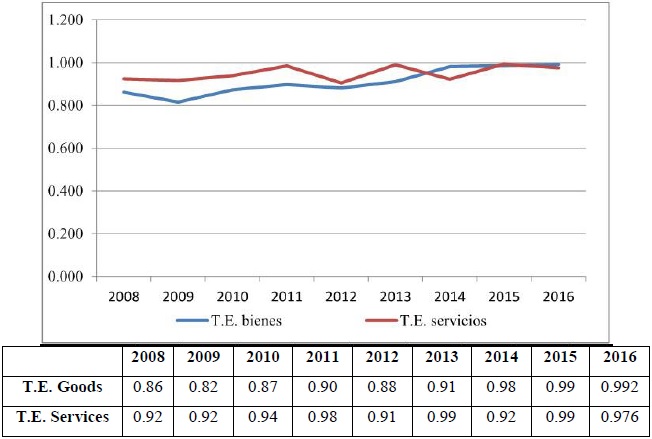
Source: Elaborated by the authors with information from Cuenta Satélite de la Cultura en México.
Diagram 1 Temporary evolution of the technical efficiency of cultural goods and services in Mexico. 2008-2016.
Moreover, by the end of the period, it is observed that both goods and services are coming closer to levels close to 1.0 or 100%. Thus, it shows a favorable evolution that converges in the optimal usage of production factors in the Mexican cultural context.
The construction of an index with a base year corresponding to the initial year of this study allows us to identify the way in which a set of variables evolves in a dimensionless manner. In Diagram 2 it can be noticed the evolution of the technical efficiency index of the cultural goods and services in Mexico. It can be observed that the efficiency of goods has a more dynamic evolution compared to the cultural services in this country.
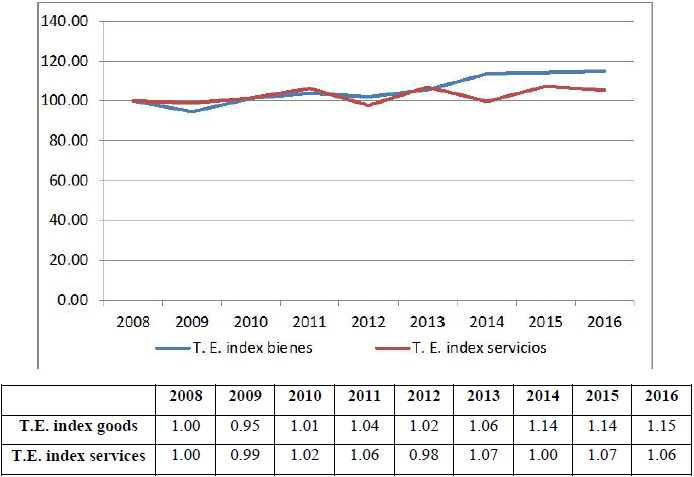
Source: Elaborated by the authors with information from Cuenta Satélite de la Cultura en México.
Diagram 2 Temporary Evolution of the Technical Efficiency Index of the Cultural goods and services in Mexico. 2008-2016.
One way to analyze if there have been gains or loss in efficiency throughout time is by obtaining the variation rate. In Diagram 3 it is presented its temporary evolution. It can be observed that there is no clear behavioral pattern regarding the efficiency gains, considering that the variation rate of the goods and the services show gains and losses behavior throughout time, although the variation rate of goods has a more stable temporary evolution. The variation rate of services has a substantial variation that goes from 9% to percentage drops of 8 points.
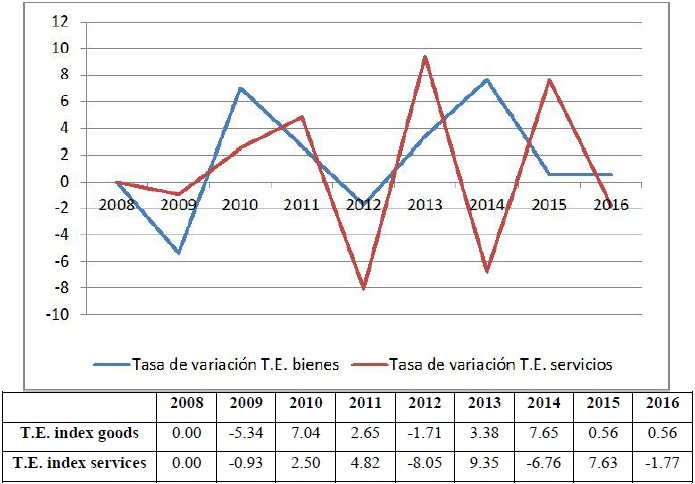
Source: Elaborated by the authors with information from Cuenta Satélite de la Cultura en México.
Diagram 3 Variation Rate of the Technical Efficiency Index of Cultural Goods and Services in Mexico. 2008-2016.
The Cuenta Satélite de la Cultura en Mexico allows us to disaggregate the cultural goods and services of this country. This disaggregation offers the possibility to study with detail the way in which its components use factors. In this way, in Table 3 the activities that integrate the cultural goods and services in Mexico are presented. Based on this classification, a more detailed analysis is done in relation to its technical efficiency.
Table 3 Activities considered as part of the cultural goods and services in Mexico.
| Full name | Simplified name |
|---|---|
| Cultural Goods | |
| Crafts | Crafts |
| Photographic equipment and film | Photographic equipment and film |
| Audio and video equipment | Audio and video equipment |
| Transmission and Reception Equipment for Radio, Television and Wireless Communication signals | Transmission and Reception Equipment |
| Musical Instruments | Musical Instruments |
| Cultural Services | |
| Cinema | Cinema |
| Edition of Books, Newspapers, Magazines and other materials. | Books and Newspapers Edition |
| Music, Radio, and other services | Music, Radio and other services |
| Design services | Design services |
Source: Elaborated by the authors with information from Cuenta Satélite de la Cultura en México.
Contrast of specification and estimation of the production function for the disaggregation of activities related to the cultural goods and services
In this section, it is performed the analysis and selection of production technology that better represents the manner in which the production factors are combined in such a way that its determination and equation is essential for the generation of outputs in the productive process.
To identify which is the adequate production function, in Table 4 it is shown a series of contrasts of likelihood ratio to choose the best functional way to estimate. The result indicates that a translog production technology is better than a Cobb Douglas. Likewise, the following contrasts indicate that the suggested variables to be included in the inefficiency equation are adequate because they reject invalid hypothesis stated.
Table 4 Contrasts of specification. Production Function for Cultural Goods and Services.
| Invalid Hypothesis | Likelihood Log. F. | ( Value | Critical value | Decision |
|---|---|---|---|---|
|
|
-52.97 | 63.35 | 7.81 | Rejected |
|
|
-60.51 | 78.43 | 19.04 | Rejected |
|
|
-56.66 | 70.72 | 15.50 | Rejected |
|
|
-60.51 | 78.43 | 18.30 | Rejected |
Source: Elaborated by the author with information from INEGI. Encuesta Anual de la Industria Manufacturera (Manufacturing Industry Annual Survey).
Once completed the likelihood ratio contrasts, and decided the adequate functional form, the estimation of the parameter value is calculated by means of the maximum likelihood method, and as a result, the estimation of the technical efficiency of the activities that integrate the cultural goods and services in Mexico is obtained. Table 5 shows the value of the parameters of equations 1) and 2) for the cultural goods and services in Mexico.
Table 5 Value of parameters. Production function for the disaggregation of cultural Goods and Services. Battese and Coelli Model (1995).
| Parameter | Value | Standard Deviation | T-Student |
|---|---|---|---|
| β0 | 4.19E+00 | 8.49E-01 | 4.93E+00 |
| β1 | -1,76E+01 | 9.10E-01 | -1.94E+01 |
| β2 | -8.71E-01 | 9.10E-01 | -9.57E-01 |
| β3 | 5.01E+00 | 5.61E-01 | 8.92E+00 |
| β4 | -3.10E+00 | 5.61E-01 | -5.53E+00 |
| β5 | 7.65E+00 | 8.45E-01 | 9.05E+00 |
| δ0 | 8.95E-01 | 8.42E-01 | 1.06E+00 |
| δ1 | -2.55E-01 | 1.76E-01 | -1.45E+00 |
| δ2 | 6.45E-02 | 9.87E-01 | 6.53E-02 |
| δ3 | 6.79E-01 | 9.52E-01 | 7.13E-01 |
| δ4 | -5.97E-01 | 1.00E+00 | -5.96E-01 |
| δ5 | 8.29E-01 | 1.00E+00 | 8.29E-01 |
| δ6 | 2.73E+00 | 7.90E-01 | 3.46E+00 |
| δ7 | -9.96E-01 | 1.01E+00 | -9.91E-01 |
| δ8 | -6.58E-01 | 1.00E+00 | -6.56E-01 |
| δ9 | -6.54E-01 | 9.98E-01 | -6.55E-01 |
| σ2 | 4.42E-01 | 5.96E-01 | 7.41E-01 |
| γ | 9.76E-01 | 2.23E-02 | 4.38E+01 |
| Likelihood Function Log. | -0.21296175E+02 |
Source: Elaborated by the authors with information from Cuenta Satélite de la Cultura en México.
Based on the estimation of the parameters considered for equations 1) and 2), we can obtain the technical efficiency of the activities that are regarded as components of the cultural goods and services in Mexico. The primary results obtained are presented below.
Once identified the activities that form the cultural goods and services in Mexico, and completed the specification contrasts for the election of the best functional form for the production function and its econometric estimation it is obtained the efficiency indicator for each one of them through time, as it is presented in Table 6. Here it can be perceived the heterogeneous nature of the efficiency indicator because some activities, such as crafts, reach levels of 0.82 or 82% in the goods category, while in services the cinema reaches the highest indicator of 0.97 or 97% thus becoming the most efficient category in both cultural goods and cultural services. Additionally, the indicators report that the activities of the services are more efficient than the activities of the goods.
It is important to highlight that the category with the lowest efficiency indicator corresponded to musical instruments, and its value was only 0.15 or 15%.
Table 6 Efficiency Indicator of the activities considered part of the cultural goods and services in Mexico.
| 2008 | 2009 | 2010 | 2011 | 2012 | 2013 | 2014 | 2015 | 2016 | |
|---|---|---|---|---|---|---|---|---|---|
| Cultural Goods | |||||||||
| Crafts | 0.76 | 0.81 | 0.75 | 0.75 | 0.72 | 0.78 | 0.74 | 0.77 | 0.82 |
| Photographic equipment and film | 0.13 | 0.12 | 0.16 | 0.17 | 0.17 | 0.72 | 0.73 | 0.70 | 0.60 |
| Audio and video equipment | 0.72 | 0.70 | 0.90 | 0.96 | 0.95 | 0.68 | 0.76 | 0.84 | 0.74 |
| Transmission and Reception Equipment | 0.33 | 0.23 | 0.19 | 0.31 | 0.32 | 0.28 | 0.40 | 0.57 | 0.71 |
| Musical Instruments | 0.11 | 0.13 | 0.13 | 0.13 | 0.14 | 0.14 | 0.14 | 0.15 | 0.15 |
| Cultural Services | |||||||||
| Cinema | 0.89 | 0.84 | 0.89 | 0.91 | 0.94 | 0.96 | 0.96 | 0.96 | 0.97 |
| Books and Newspapers Edition | 0.88 | 0.82 | 0.82 | 0.78 | 0.87 | 0.81 | 0.81 | 0.85 | 0.87 |
| Music, Radio and other services | 0.64 | 0.65 | 0.75 | 0.65 | 0.81 | 0.78 | 0.83 | 0.87 | 0.90 |
| Design services | 0.86 | 0.83 | 0.80 | 0.80 | 0.88 | 0.84 | 0.92 | 0.87 | 0.88 |
Source: Elaborated by the authors with information from Cuenta Satélite de la Cultura en México.
The Average Technical Efficiency index of the components of cultural goods and services in Mexico is shown in Diagram 4. As it can be observed, it has evolved in a crescent manner since 2008 reaching an indicator of 0.67 or 67%. This result allows concluding that on average there is a moderate level in the use of production factors in activities related to the components of cultural goods and services in this country.
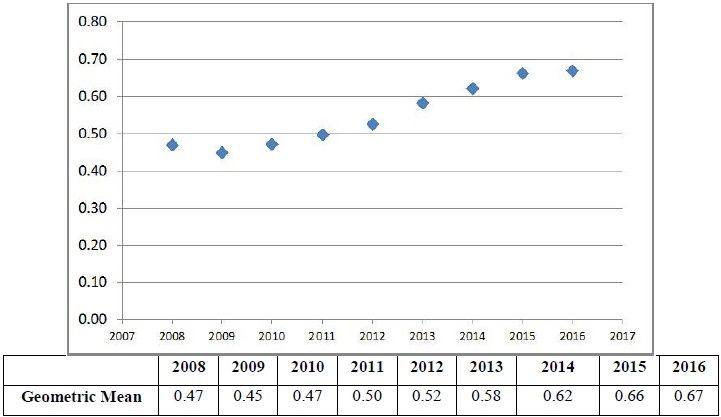
Source: Elaborated by the authors with information from Cuenta Satélite de la Cultura en México.
Diagram 4 Temporary evolution of the Index of Average Technical Efficiency of Cultural Goods and Services in Mexico. 2008-2016.
From a different perspective, the average technical efficiency of the components of the cultural goods and services is presented in Diagram 5, where two segments can be observed. The first one corresponds to the average of the components of cultural goods, whereas the second one corresponds to the average of the components of cultural services. It can be noticed that the efficiency indicator is higher for cultural services, which fluctuates at about 0.85 or 85% although the indicator of the audio equipment category that belongs to cultural services is 0.80, which, in percentage, equals 80%.
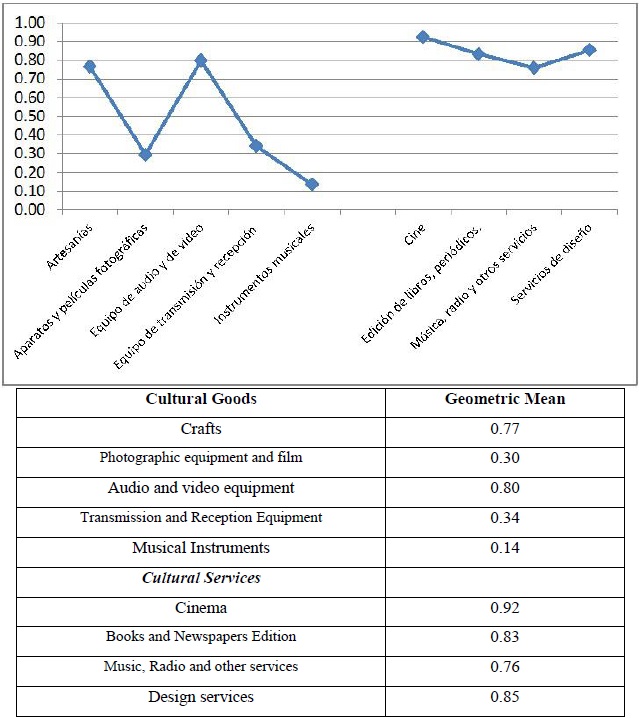
Source: Elaborated by the authors with information from Cuenta Satélite de la Cultura en México.
Diagram 5 Average Technical Efficiency of Cultural Goods and Services in Mexico.
Once obtained the technical efficiency indicator of the components of the cultural goods, it is generated an index based on the first year of the study period, which is presented in Diagram 6. It is noticed that, except for the category related to photographic equipment and film, the rest barely have a slight index growth, and they are very close to the initial value of 100.
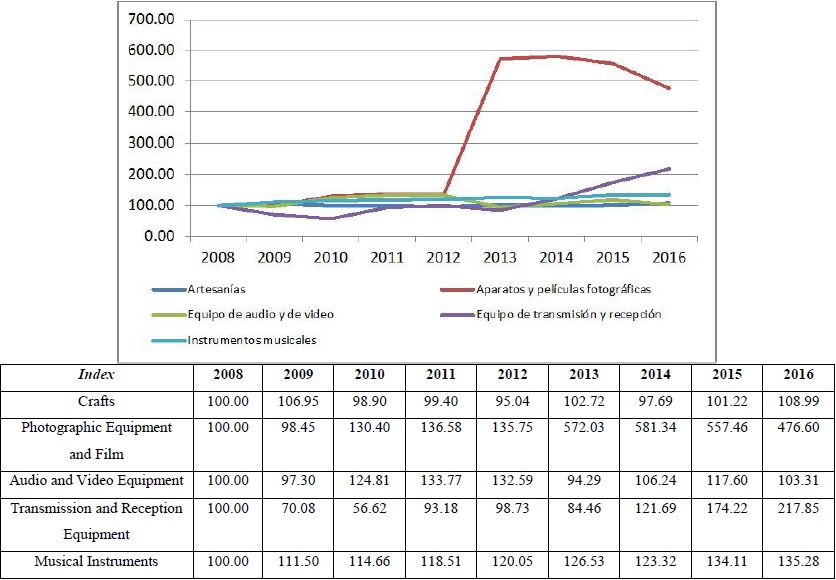
Source: Elaborated by the authors with information from Cuenta Satélite de la Cultura en México.
Diagram 6 Temporary Evaluation of the Technical Efficiency Index of Cultural Goods in Mexico. 2008-2016.
In a similar way in which the index was created for the components of cultural goods, another one is created for cultural services, which is presented in Diagram 7. It can be appreciated that the cinema has the most favorable evolution in this category, reaching an index of 139 points in 2016, thus it is deemed the most dynamic. Likewise, the Book and Newspaper Edition category is shown as less dynamic, and it even presents an unfavorable evolution throughout the years of this analysis, concluding in 2016, with an index of 98 points, two units below the initial value.
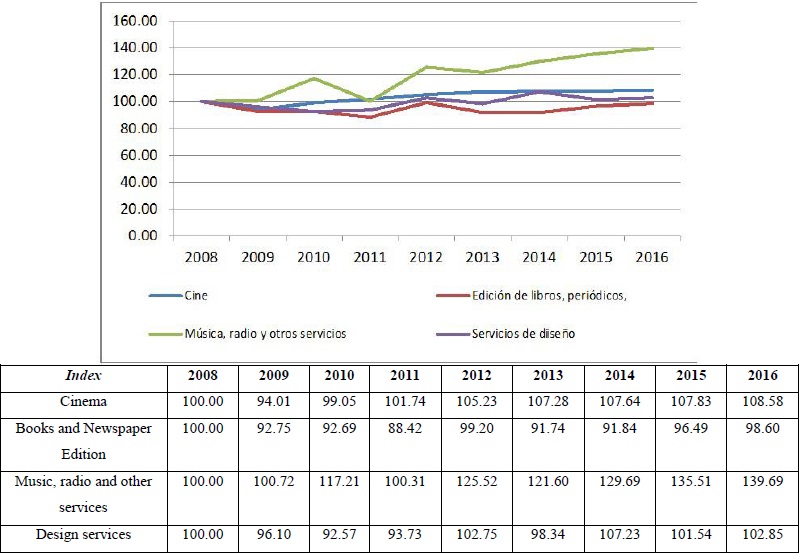
Source: Elaborated by the authors with information from Cuenta Satélite de la Cultura en México.
Diagram 7 Temporary Evaluation of the Technical Efficiency Index of Cultural Services in Mexico. 2008-2016.
The variation rate of the efficiency of the components of cultural goods is presented in Diagram 8, where it is noticeable the growth rate of the Photographic Equipment and Film category, as it reported a 321% growth in 2013. However, the other components of the services display alternating growth and decrease rates with strong variations, as it can be noticed in the table located next to Diagram 8.
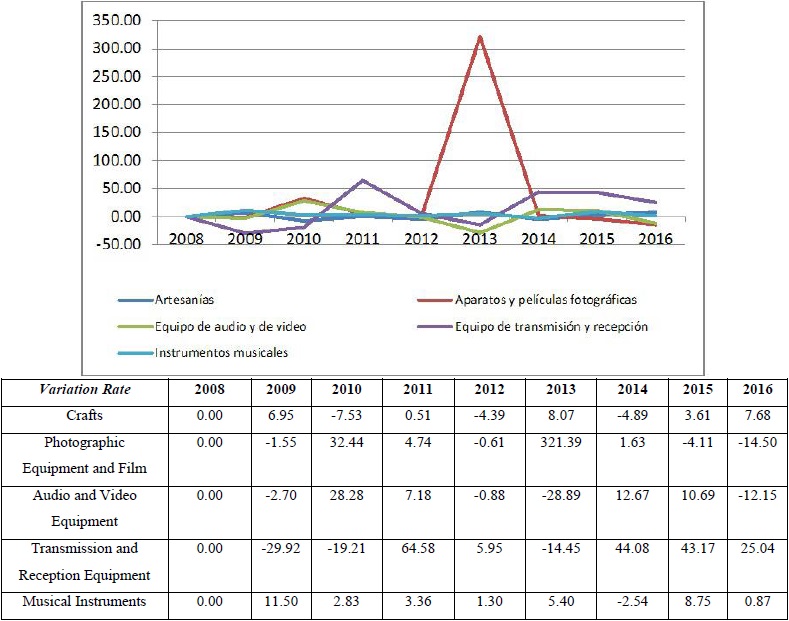
Source: Elaborated by the authors with information from Cuenta Satélite de la Cultura en México.
Diagram 8 Variation Rate of the Technical Efficiency Index of Cultural Goods in Mexico. 2008-2016.
The temporary evolution of the variation rate of the cultural services is present in Diagram 9. There the disparities in growth or decrease of the categories that belong to cultural services can be observed. Music, Radio and Other Services have a very prominent variation rate reaching a growth rate of 25.13% in 2012 in contrast to the previous year. Cinema is the exception, as it is the only category with growth rates, the rest show alternating behaviors of growth and decrease in terms of the efficiency indicator.
Conclusions
Having a data panel concerning the economic indicators of culture in Mexico has allowed estimating the technical efficiency of the cultural goods and services, as well as the decomposition of its components, and to estimate their efficiency in a disaggregated manner. Particularly, when the indicator is obtained for the cultural goods and services in an aggregated manner, the results indicate that they are highly efficient.
The index of efficiency temporary evolution demonstrates that Goods are the most dynamic one. However, the variation rate for both categories is very erratic, as it was noticed in the temporary evolution of the variation rate.
In order to have a better understanding of the technical efficiency, id est, about the way in which the production factors are used, an analysis of the components of the cultural goods and services has been performed based on the disaggregation of the Cuenta Satélite de la Cultura de México.
Among the findings, there is the fact that the geometric mean of the technical efficiency of the cultural goods and services components reached a level of 67% in 2016, thus being the lowest level in relation to the added categories. It was also noted that the components of the cultural services are more efficient than the cultural goods.
In the category of components of cultural goods, it is noted that, except for Photography equipment and films, the other ones have barely had a slight efficiency index growth, as it has not changed much from the initial value of 100. In the category of components of services, it is noticeable that Cinema has had the most favorable evolution, as it reached a 139-point index in 2016, thus becoming the most dynamic.
It is also worth mentioning that the variation rates of the components of cultural goods and services have been very erratic, as they have had substantial variations, and they have alternately shown growth and decrease rates throughout the analysis years.











 nueva página del texto (beta)
nueva página del texto (beta)



